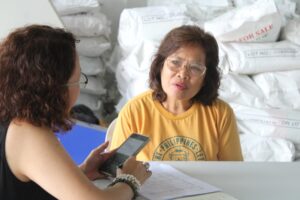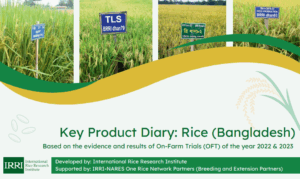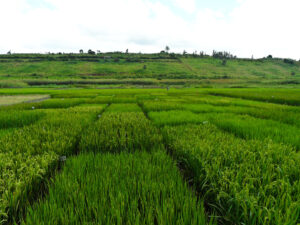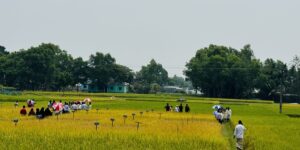by Preeti Bharti, Deepti Saksena, Sheetal Sharma, and Ranjitha Puskur
The Rice Crop Manager (RCM) has proven to be an effective farmer-friendly digital tool to increase productivity and incomes of rice farmers through balanced fertilizer management. The two case studies presented here highlight how women and young people have used RCM on their farm and successfully reduced their input costs, increased yields and the net benefits.

The Rice Crop Manager (RCM) is a tailor-made, web-based tool that follows site-specific nutrient management principles. It gives rice farmers recommendations for applying the right amount of essential nutrients for their crops at the right time, along with weed and nursery management recommendations.
RCM has been disseminated under the project Increasing Productivity of Rice-based Cropping Systems and Farmers’ Income in Odisha, implemented by the International Rice Research Institute (IRRI) with the support of the Department of Agriculture and Farmers’ Empowerment (DA&FE) in Odisha, India.
The five-year (2016-2021) project aims to enhance the lives of farmers in the state who are dependent on rice-based cropping systems through improved agricultural management practices, innovations, and technologies.
During the project, RCM was used to provide fertilizer use recommendations to around 200,000 thousand men, women, and young farmers. Evidence and learning from the field have shown that the farmers who have been practicing and adopting the technology, and benefiting from it, were also promoting RCM to their fellow farmers. The two case studies presented here highlight how farmers have taken simple steps to use RCM on their farm and successfully reduced their input costs and experienced the net benefits.
The two case studies presented here highlight how farmers have taken simple steps to use RCM on their farm and successfully reduced their input costs and experience the net benefits.

RCM: A key to empowering the women farmers of Kalahandi
Maa Tarini is a women’s self-help group formed in 2018 by ten women who worked at an Anganwadi (rural child care center) to improve their livelihood. Their main source of income during the kharif season is rice cultivation. In rabi, because of limited water availability, they cultivate vegetables. The male members of the family are laborers who go to nearby districts to engage in construction work. In their absence, these women farmers take care of their rice farms performing transplanting, weeding, harvesting, and postharvest operations.
Lutheran World Services India Trust (LWSIT), an NGO working in the area, introduced RCM to the women farmers. IRRI and LWSIT conducted training to impart skills to use RCM to these women. The NGO staff interviewed them through mobile phones using the built-in questionnaire in the application and asked them about the variety they use, previous yield, method of harvesting, and other crop management practices. Within seconds, the RCM generated specific recommendations for their rice crop to be grown in a particular patch.
The women were happy to see their names and location flashing on the page. They were given a printed copy of the recommendation to be followed throughout the season, which they shared with their husbands. The advisories provided in the table were in Odia language, very simple and easy to understand. Along with the correct amount of fertilizer to use, they also learned the exact time for fertilizer application.
RCM recommended increasing the amount of urea (nitrogen or N) by 20% applied in three doses instead of their regular two-split application. It advised reducing diammonium phosphate (phosphorous or P) by as much as 34% compared to their regular practice. Although reluctant at first, they decided to follow the recommendation as the advisory predicted a higher yield.
Previously, they harvested 3.8-4.2 tons per hectare (t/ha) of rice using their traditional practice. After following RCM, they experienced a yield gain of 0.8-1.4 t/ha. So, together with saving fertilizer cost by applying less DAP which is an expensive fertilizer compared to urea and extra income from higher yield, the net benefit for them was higher by around USD 280 per ha.
They now follow RCM advisories and are thankful to the NGO staff for this new technology to them. Two women farmers in the group who have smartphones have learned how to use the application and are generating the advisories for themselves and other members. Those who could not use RCM on their own have asked their children to learn to use the application so that they can continue to get the advisories in the future.
“We encourage other farmers of our village to use this technology as we have experienced the benefits ourselves,” said Chanchala Manjhi, a women farmer and a member of Maa Tarini.
The rural youth as drivers of change in agriculture
Sudarshan Sahoo from Jaypurpatna, a village in the outskirts of Bhubaneswar City, is a 23-year-old man who belongs to a farming family of five. Agriculture is the primary source of income for the family. They grow rice, pulses, and vegetables in their 1-hectare land.

Sudarshan, who is studying for his Bachelors of Arts degree, has always been interested in learning new technologies related to farming. Sudarshan has seen how the yield has increased in the past ten years from 2-2.5 t/ha to 4.5-5 t/ha by adopting improved varieties, green manuring with dhaincha (Sesbania aculeata), and practicing crop rotation with pulses, line transplanting, weed management, and nutrient management.
Sudarshan always attends training programs conducted by extension agents in his village with his father who is a Krushak Sathi or lead farmer who serves as a contact point for dissemination of agriculture technology to other farmers in their respective villages.
In 2018, when IRRI and DA&FE held a meeting in their village and introduced RCM, his father, an innovative farmer, followed RCM recommendation on 800 square meters of their land using Lalkuber variety. He adjusted the levels of P and N fertilizers based on the RCM recommendation and was happy to see that despite lowering the doses, he obtained an additional yield of 0.7 t/ha.
Keen on learning how to use RCM after seeing the benefits, Sudarshan attended the training on RCM conducted by IRRI so he could also generate the tool’s recommendations. Sudarshan’s training turned out to be a great boon during the 2020 kharif when the COVID-19 lockdown was imposed and the visits of extension staff were suspended. He decided to generate RCM recommendations for his plots as well as for the neighboring 24 farmers.
“I learned this technology to transfer information on accurate timing and doses of fertilizer application to my father and other farmers of my village so that the yield of our rice crops will increase along with savings on fertilizers,” said Sudarshan.
These case studies indicate how digital tools like RCM can help create awareness among farmers and encourage them to apply balanced fertilizer applications to improve soil fertility, productivity and, consequently, increase the net returns of farmers.
RCM, available for free here, is compatible with mobile phones, laptops, and tablets running on the Android or Windows operating system.






